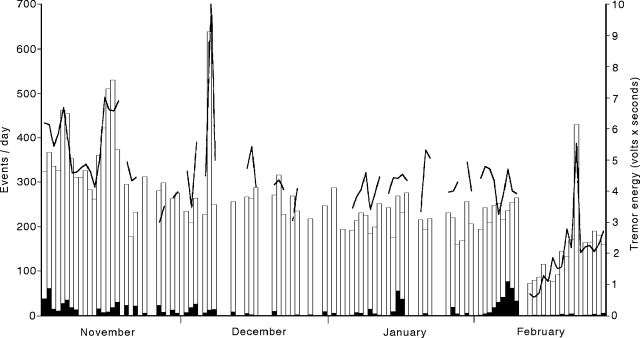Report on Stromboli (Italy) — February 1993
Bulletin of the Global Volcanism Network, vol. 18, no. 2 (February 1993)
Managing Editor: Edward Venzke.
Stromboli (Italy) Seismicity and tremor resume after 10 February explosions
Please cite this report as:
Global Volcanism Program, 1993. Report on Stromboli (Italy) (Venzke, E., ed.). Bulletin of the Global Volcanism Network, 18:2. Smithsonian Institution. https://doi.org/10.5479/si.GVP.BGVN199302-211040
Stromboli
Italy
38.789°N, 15.213°E; summit elev. 924 m
All times are local (unless otherwise noted)
Seismicity between 1 November 1992 and 28 February 1993 was stable except for two episodes of heightened activity (figure 28). High tremor energy and >25 explosion-earthquakes/hour were recorded on 6 December. On 10 February, three strong explosions occurred followed by a sudden decrease of tremor to about one-sixth the energy and one-third the number of events. In the week preceding the 10 February explosions, a large number of strong shocks occurred, with a maximum of 76 on 7 February. After a few days of low seismicity following the explosions, tremor amplitude and the number of events gradually increased, reaching an isolated maximum on 22 February.
Geological Summary. Spectacular incandescent nighttime explosions at Stromboli have long attracted visitors to the "Lighthouse of the Mediterranean" in the NE Aeolian Islands. This volcano has lent its name to the frequent mild explosive activity that has characterized its eruptions throughout much of historical time. The small island is the emergent summit of a volcano that grew in two main eruptive cycles, the last of which formed the western portion of the island. The Neostromboli eruptive period took place between about 13,000 and 5,000 years ago. The active summit vents are located at the head of the Sciara del Fuoco, a prominent scarp that formed about 5,000 years ago due to a series of slope failures which extends to below sea level. The modern volcano has been constructed within this scarp, which funnels pyroclastic ejecta and lava flows to the NW. Essentially continuous mild Strombolian explosions, sometimes accompanied by lava flows, have been recorded for more than a millennium.
Information Contacts: M. Riuscetti, Univ di Udine.


